Phacelia bipinnatifida , Purple Phacelia, is biennial herbaceous plant that blooms in spring. It is rare in New Jersey. It has many common names including: Fern-leaf Scorpion-flower, Forest Phacelia, and Fern-leaf Phacelia
Flowers
Inflorescence/Flower cluster:
The cluster is termed a panicle meaning the flower stem has many branches with flowers. The 4 to 12 flowers and buds tend be at the ends of the branches. However, as the flowers mature, the branches grow, so that the fruits develop along the branch with the flowers at the ends.
Flower:
Each flower is about a half inch across with pale lavender to blue petals and a white center. The 5 petals fuse near the base forming a shallow bowl with spreading petals. The flower has 5 sepals, 5 stamens attached to the petals, and one pistil with a long style that splits into two long stigmas. The stamens and pistils extend a good distance beyond the corolla. Also there are 5 corolla appendages in the white area.
There are lots of hairs some glandular: The stamen filaments have long hairs that spread mostly away from the filaments. The ovary is green and covered with hairs that point outward from the base. The sepals are hairy and the flower stalks (pedicels) are hairy. The corolla appendages are hairy too.
In the 2 photos directly below, the main flower parts can easily be seen: petals, blue stamen filaments with long hairs radiating out and upward, tan anthers and also shriveled old anthers, long white styles split in two. The green ovary is obscured by all the hairs. Also hairs on the sepals can be seen.

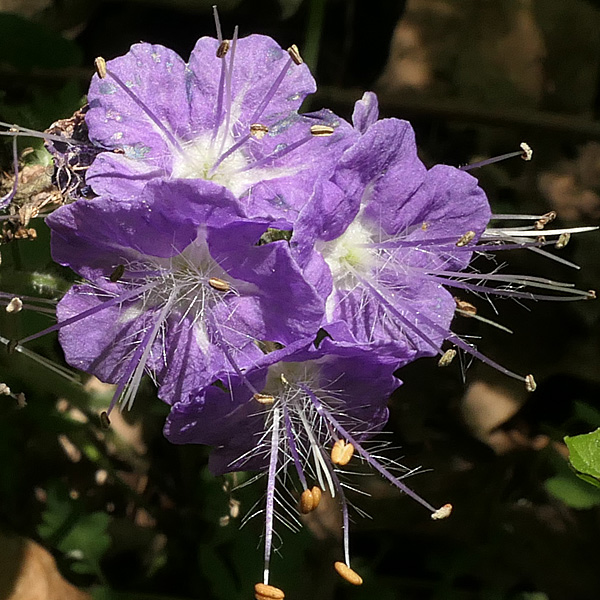
This side/back view shows where the petals are fused together and forms shallow bowl at the base. Also seen are the hairy sepals and the hairy flower stalk (pedicel)

In this front view, the ends of the 5 corolla apendages are located where the white area radiates out into the middle of the lavender petals.
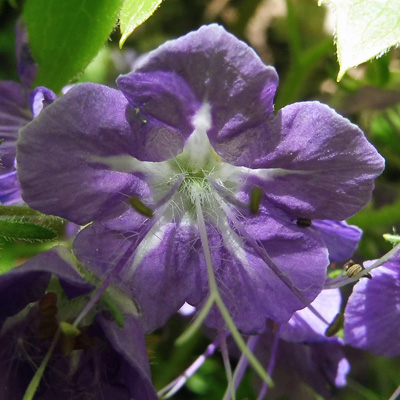
White flowers are not common.
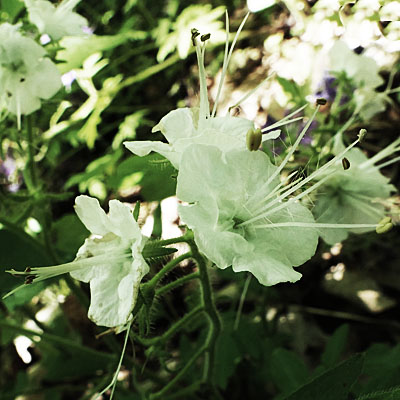
Floral appendages:
Britton & Brown uses floral appendages in their key to the Phacelias. We made a big effort to see what they looked like. It is not clear what their function is; maybe involved with scent or nectar production.

The corolla tube (petals with attached stamens) easily seperated from the flower leaving behind the pistil attached to the sepals on the plant. Then the stamens (brown spots) were cut off so as to see the corolla appendages easier.
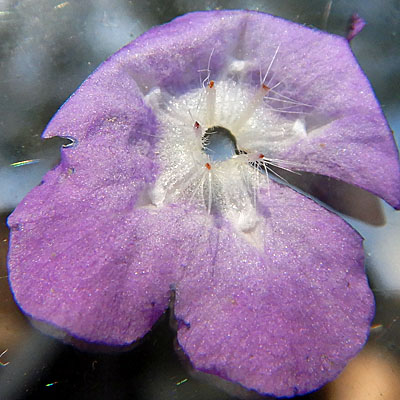
A close-up of view showing the corolla appendages as pairs of raised stripes terminating in a white lump.
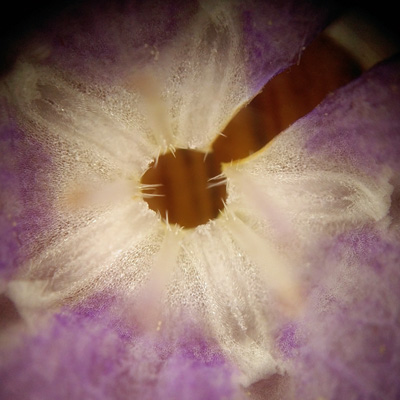
In this close-up of view, short hairs can be seen between the appendage pair.
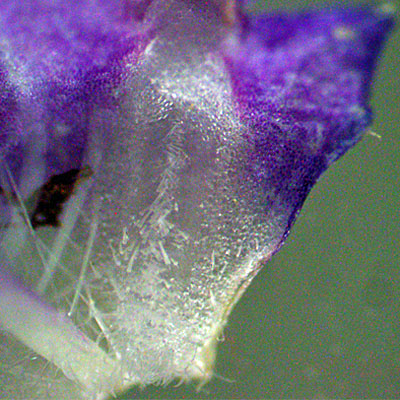
Fruit & Seeds
When the flower is done, anthers depleted and/or the flower is pollinated, the corolla with the attached stamens drop off.

The flowers tend to be terminal on their stems but when the flower begins to fruit, the stems elongate so that the fruits are strung out along a long stem.
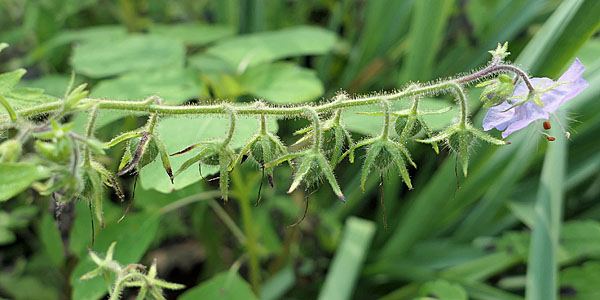
The ovary starts out green and turns dark at maturity. Notice all the hairs and the remaining style.
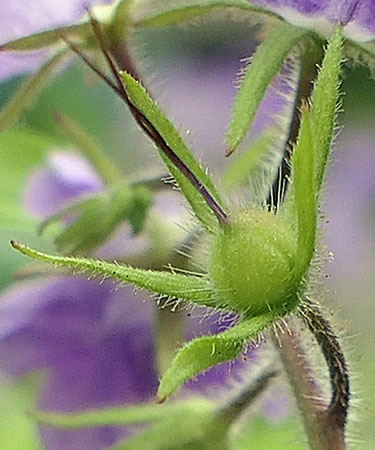

First photo below: Opened seed case with compartments for 4 seeds but one of the seeds did not develop properly. Second: seed with ornamentation.
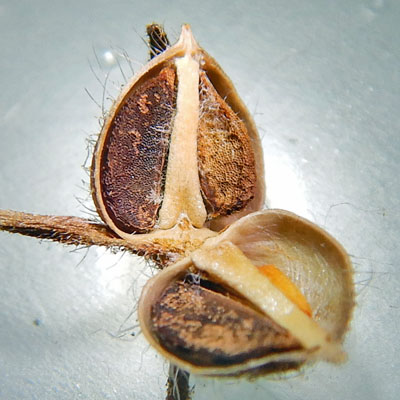
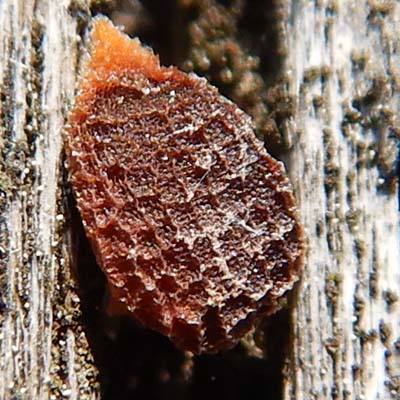
Leaves
Leaves: Purple Phacelia (Phacelia bipinnatifida) is a biennial plant which means that it finishes it life cycle in two growing seasons. The first year it has basal leaves which grow and over-winter. The second year, it send up flower stalks with cauline (on the flower stalk) leaves.
The two round leaves are the cotyledons (seed leaves) and above them is a true basal leaf.

The leaf blade is lobed sometimes into leaflets. The leaf stems (petioles) are variable in length. The basal leaves continue to grow through the season.
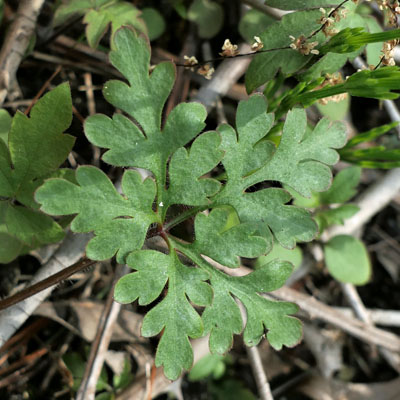
The cauline leaves are alternate and up to 5 inches long with 3 to 5 leaflets and the petioles are usually shorter higher up the flower stalk. The leaves are slightly hairy on both surfaces and on the edges and on the petioles. The lower surface is paler than the upper surface.


Plant & Habitat & Rarity
Purple Phacelia is a biennial plant meaning that the plant takes two growing seasons to complete its life-cycle. During the first year is just produces leaves that overwinter. The over wintered leaves may be a bit battered the second year but that gives the plant a head start. The second year the plant produces flowers and seeds and then dies afterwards.
Purple Phacelia plant is 1 to 2 feet tall with branching. The stems are covered with spreading hairs and some are glandular.
Purple phacelia is usually found in moist areas of rocky woodlands. We observed this plant in the wild in Sussex County in rocky woodlands. We have it in cultivation (seeds from elsewhere) in photos below. The plants are doing very well in purchased 'garden soil' in partial sunlight. In the wild the plants were quite shaded and were small except in one sunny location where the plants were bushy like in the photo below.
Purple phacelia's conservation status is G5(Globally secure)/New Jersey S1 (Critically Imperiled). Since this plant does not seem to require very special conditions, purple phacelia is a good candidate for restoration. Citizen scientists could be utilized to secure the survivial of this plant in New Jersey.
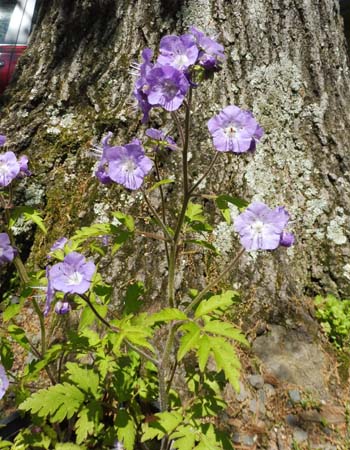
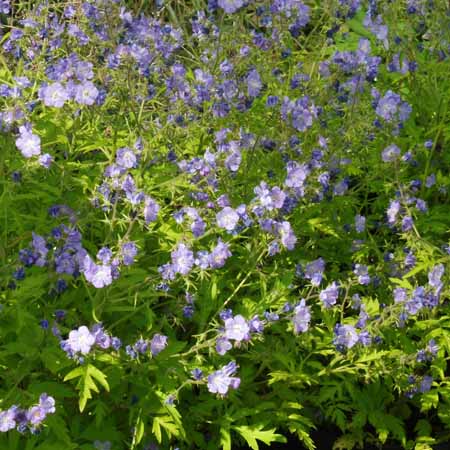
Text by Millie Ling and all photos by Hubert & Millie Ling. Photos: flowers in Sussex County - May 12, 2021, plants in cultivation -May 2021 & 2022
Additional information
Additional information / references:
- The USDA website shows Phacelia bipinnatifida distribution in the US and other information: https://plants.sc.egov.usda.gov/home/plantProfile?symbol=PHBI2
- Rarity in US: InNew Jersey S1 (Critically Imperiled). It may be G5 but it is vulnerable in many of the states that it is in: https://explorer.natureserve.org/Taxon/ELEMENT_GLOBAL.2.161584/Phacelia_bipinnatifida
- Conservation Status Definitions: https://help.natureserve.org/biotics/content/record_management/Element_Files/Element_Tracking/ETRACK_Definitions_of_Heritage_Conservation_Status_Ranks.htm
- Illinoiswildflowers: https://www.illinoiswildflowers.info/woodland/plants/forest_phacelia.htm
- Missouriplants: http://www.missouriplants.com/Phacelia_bipinnatifida_page.html
- SouthWestBioDiversity: https://swbiodiversity.org/seinet/taxa/index.php?taxon=94832&clid=5393